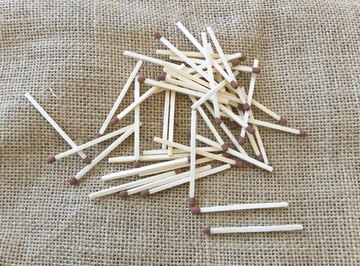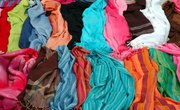
Fashion designers in the 21st century often use scientific knowledge to help them create great looking clothing that's also functional, durable and protective. Young students can prepare for possible careers in the high-tech fashion industry by creating projects that explore important scientific clothing principles.
Ensure that adults supervise all projects that involve working with fire.
Keeping Fashionably Warm
Whether it's at home or onboard a spacecraft, good insulating materials are vital to prevent heat loss. You can test the insulating capabilities of different clothing materials, such as cotton, wool and rayon, by creating a refrigeration project. Fill a jar with hot water of about 85 Celsius (185 Fahrenheit) and place it in a refrigerator at about 5 Celsius (41 Fahrenheit). Record the water's temperature every quarter-hour for an hour and repeat this test 10 times. Wrap another jar of hot water -- the same temperature -- in one of your clothing materials and record water temperature changes as you did with the first jar. Repeat the test for the other clothing materials and review the results when you're done. The best insulator is the one that lets the least heat escape.
When Clothing Burns
Clothing can help you look great, but don't forget its other important function -- protecting you. Because various clothing materials burn at different rates, you can develop a science project that measures fabric flammability. Cut different clothing samples into small swatches of about 5 square centimeters (2 square inches). Materials you might choose include cotton, silk and polyester blend. Grab a swatch with tongs and light the material on fire over plate glass. Have someone else use a timer to record the amount of time it takes for the swatch to burn. Repeat the experiment with different clothing swatches and analyze your results when you're done. You'll discover the flammability rates of your test materials.
Water, Water, Everywhere
Some materials absorb lots of water, while others are waterproof and repel it. Obtain samples of different fabrics you'd like to test and cut them into 15-centimeter (6-inch) squares. Secure one square to the top of a cup with a rubber band and place the cup in a pie plate. After you fill a small plastic cup with water, pour all the water over the fabric. Depending on its absorbency, different amounts of water flow through the fabric into the cup. Fabrics such as nylon absorb little water, so a lot will end up in the cup. Remove the fabric, record the amount of water inside the cup and repeat these steps using your other clothing samples. When you're done, review the data and rate the absorbency of your materials. Fabrics that allow the most water into the cup are the least absorbent.
If one or more samples in this project have special fabric treatments, the experimental data may be affected. For instance, an absorbent material coated with a water-repelling treatment may absorb less water than a corresponding sample that doesn't have that treatment.
The Temperature Factor
Many people wear lighter clothing while working in the heat because darker clothing absorbs more light that then gets converted to heat. Verify this fact by measuring the amount of heat that black and white clothing samples absorb. Wrap a piece of black fabric around a glass filled with water and secure it with tape or an elastic band. Repeat this process with a piece of white fabric, ensuring that each glass contains the same amount of water. Leave the glasses in the sun for a few hours, then record the water temperature in each glass. Your data will prove that darker materials absorb more heat than lighter ones.
References
About the Author
After majoring in physics, Kevin Lee began writing professionally in 1989 when, as a software developer, he also created technical articles for the Johnson Space Center. Today this urban Texas cowboy continues to crank out high-quality software as well as non-technical articles covering a multitude of diverse topics ranging from gaming to current affairs.
Photo Credits
Sergejs Razvodovskis/Hemera/Getty Images
